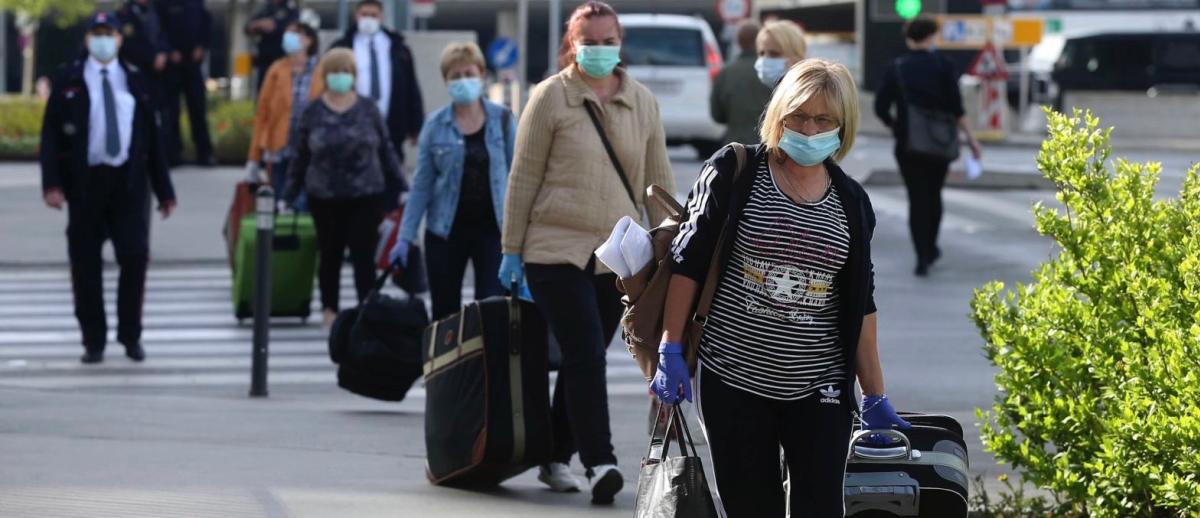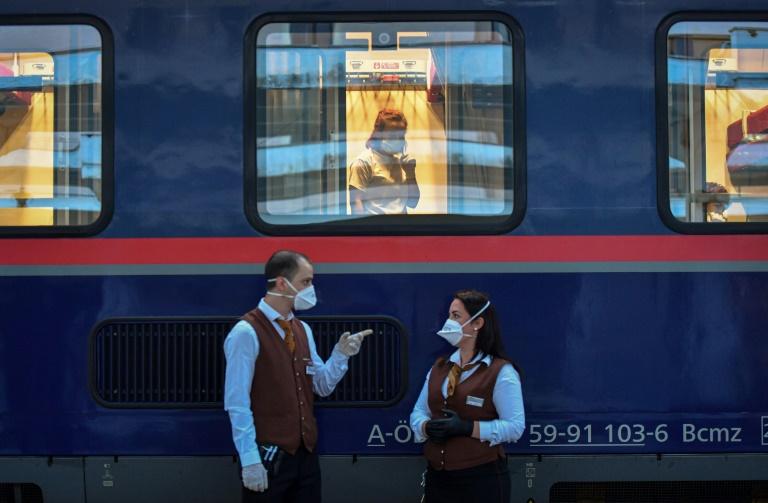European Borders, COVID-19, and the Economy of Home Care
archive


Romanian care workers accompanied by police and security at Vienna's airport in May, 2020. (Photo credit: AP)
European Borders, COVID-19, and the Economy of Home Care
For the European Union, free movement of EU citizens within EU is an important element of the very idea of a united Europe. The right to freedom of movement is guaranteed by Article 21 of the Treaty on the Functioning of the EU (TFEU). It states that “Every citizen of the Union has the right to move and reside freely within the territory of the Member States.” This should especially serve the further development of a European economy, where a European work force can fulfil labor market demands where needed across national borders.
The COVID-19 pandemic changed that. All of a sudden, the European Union got fragmented again into 28 national states each with their respective responses to the pandemic. National public health policies demanded the closure of national borders and overruled the freedom of movement. As health issues of EU member states are subject to national regulations, countries established different policies of border control and regulations on who is allowed to travel under which circumstances, and how matters of quarantine are handled. National borders were seen as the most important checkpoints for controlling the spread of COVID-19.
Ironically, this has a tremendous negative consequence especially for the health care sector in rich EU countries which depend on migrant health care workers. The closure of EU-internal borders furthermore revealed the relevance of a borderless EU for another important health issue: care for the elderly. Countries like Austria are characterized by an ageing population and consequently elder care, either in nursing homes or at home, has become a major challenge.
Austria, Romania and the Economy of Home Care
Like other rich and ageing countries, Austria is depending on a migrant workforce to meet these growing demands. The big wage gap (differences between the rich and the poor EU member states) makes it attractive enough for people—predominantly women—from poorer EU regions to leave their own families and work in a highly demanding environment as live-in care workers or so called “24h carers.”
In Austria, approximately 460,000 persons are registered as in need of care. They belong to the high-risk group concerning COVID-19, with a mortality risk 50-80 times higher than people under 50 years of age.2 In order to support them, in 1993, the government established a so-called “Pflegegeld,” a taxed-based, non-means-tested cash benefit scheme covering all groups of people with disabilities and in need of care, with the main purpose to support care provision at home instead of relying on institutional services (Gendera, 2011). The lack of restrictions on how the cash allowance should be spent has helped to foster development of a large, informal, and migrant-dominated 24-hour home care sector in Austria (Gendera, 2011; Bauer & Österle, 2016).
Official regulations were finally adopted after a public scandal in 2006 when it was revealed that the Austrian chancellor’s mother-in-law was attended to by an informal caregiver from the black labor market. Austria then legalized the grey economy of home care by gradual and complex legislative changes spanning the years 2006, 2007, and 2008 involving the regulation of work permits, employment, and long-term care-provision (Bahna & Sekulová 2019, Bauer & Österle, 2016). The new regulations allow 24-hour care to be delivered under the existing regulations for self-employment and formally turned caregivers into entrepreneurs. This entails allowing working hours far beyond those in regular employment and lower social security contributions. Despite their self-employment-status most 24h caregivers are brokered by agencies, which take a considerable amount of money for their services both from the cared person and from the caregiver. Language barriers make it practically impossible for 24h caregivers to master the complex regulations and administrative demands connected to their self-employed status. This puts most of them in a state of dependency from their brokers.
All of a sudden, the European Union got fragmented again into 28 national states each with their respective responses to the pandemic.
In 2020, Romania is the leading source country of 24-hour care providers in Austria. Around 40,000 of the 60,000 caregivers working on self-employment contracts are Romanian. They work on fortnightly and four-week alternating shifts, usually staying in Austria for four weeks, then travelling home, and coming back for the next shift (Leichsenring, et al. 2020).
Austrian and Romanian responses to COVID-19: Consequences for 24h care
The coronavirus pandemic started in Austria on February 25, 2020 with two reported cases in Innsbruck, the capital of the federal state Tyrol. Tyrol has been internationally criticized for the spreading of the virus in Europe due behaviors among tourists enjoying after-ski parties and then returning to their home countries.
Austria started travel restrictions on March 9 by banning incoming flights from affected regions, followed by re-introducing border controls and stopping railway travel to Italy on March 10. General restrictions of movement in public were also introduced and borders to all neighboring countries were closed.
On March 14, Romania declared a state of National Emergency with 123 confirmed cases of COVID-19. On March 25, a nation-wide lockdown was introduced. To reduce the number of imported infection cases, fourteen days home-confinement or quarantine were required of persons coming from affected regions. The President and the Prime Minister asked the many Romanians living abroad as seasonal workers not to return to the country. The government furthermore closed its borders to foreign citizens and stateless persons, and all commercial flights to and from most countries were suspended.
The economy of 24h home care in times of COVID-19
When the borders closed, many caregivers became stranded either in the households of their patients, or at home in Romania, where they are without income. Austrians were affected as well, since caregivers could not be replaced due to the closure of borders and quarantine regulations.
This created a state of emergency in home care for the elderly. The Austrian federal government reacted with two main measures: 1) the introduction of a 500 Euro bonus for caregivers who extended their shift for at least four weeks, and 2) negotiations with neighboring countries for travel corridors for care workers and implementation of dedicated means of transportation via airplanes and trains. With Hungary lying between the two states, Austria negotiated special arrangements of border control and passage. From the second weekend of May, special trains started to bring caregivers from Romania through Hungary to Austria every week and guaranteed their return as well.

night train transports care workers between Timisoara, Romania, and Vienna, May 2020. (Photo credit: AFP)
Travelling costs have increased considerably in COVID-19 times. Taking the official trains, the one-way ticket is 100 Euros; incoming caregivers have to be tested (the test costs 105 Euros) and spend some nights at a hotel at a cost of 74 Euros/night. Taking private buses, the one-way ticket is now about 350 Euros, more than triple what it cost before. Moreover, caregivers need to get off the bus at the border between Hungary and Romania, cross the border on foot, and wait for their bus on the other side. This can take several hours. Why do the workers put up with these conditions? The average monthly income of a worker in Romania is about 300 Euros, and a 24h caregiver in Austria gets around 70 Euros for a 22-hour working day.
When the borders closed, many caregivers became stranded either in the households of their patients, or at home in Romania, where they are without income.
Caregivers could stay in Austria for longer time, but this would blow up the overall concept of staying under the threshold of paying taxes in Austria. They could stay more days in a row, but this does not seem to be the norm so far, for reasons that have not been systematically evaluated.
Conclusions
COVID-19 revealed that the European Union is a fragile construct that can easily get back into national state mode in times of serious trouble. The closure of borders revealed the dependency of national public health system on foreign caregivers. It also revealed dependency on a private sector of care provision. It seems that public health systems in highly developed and rich countries cannot sufficiently provide adequate structures and support to take care of their growing elderly populations. Moreover, many countries fail to compassionately account for the complex healthcare and labor issues at stake. In Austria, for example, the homecare crisis under COVID-19 was managed not by the Ministry of Health, but rather by the Chamber of Commerce.
The economy of 24-hour care is in no respect a part of the formal public health system. Instead, it seems to be run by private agencies following a market-driven approach with a goal of maximizing profit. An important element is to make use of cheap labor that is offered by the socio-economic inequality among European countries. These disparities became more apparent due to the COVID crisis and hopefully important lessons have been learned. Yet if inadequate elderly care services are truly of grave concern to affluent European countries, then public health policy should offer meaningful solutions that account for the needs of both elderly populations and their migrant caregivers.
Bahna, Miloslav & Sekulová, Martina (2019) Crossborder Care. Lessons from Central Europe. Switzerland: Palgrave Macmillan.
Bauer, G., & Österle, A. (2016) “Mid and Later Life Care Work Migration: Patterns of Re-Organising Informal Care Obligations in Central and Eastern Europe.” Journal of Aging Studies, 37: 81–93, doi.org/10.1016/j.jaging.2016.02.005.
Leichsenring, K, Staflinger H, Bauer A (2020) Report: The importance of migrant caregivers in the Austrian Long Term Care system highlighted by the Covid-19 outbreak. Article in LTCcovid.org, International Long-Term Care Policy Network, CPEC-LSE.



